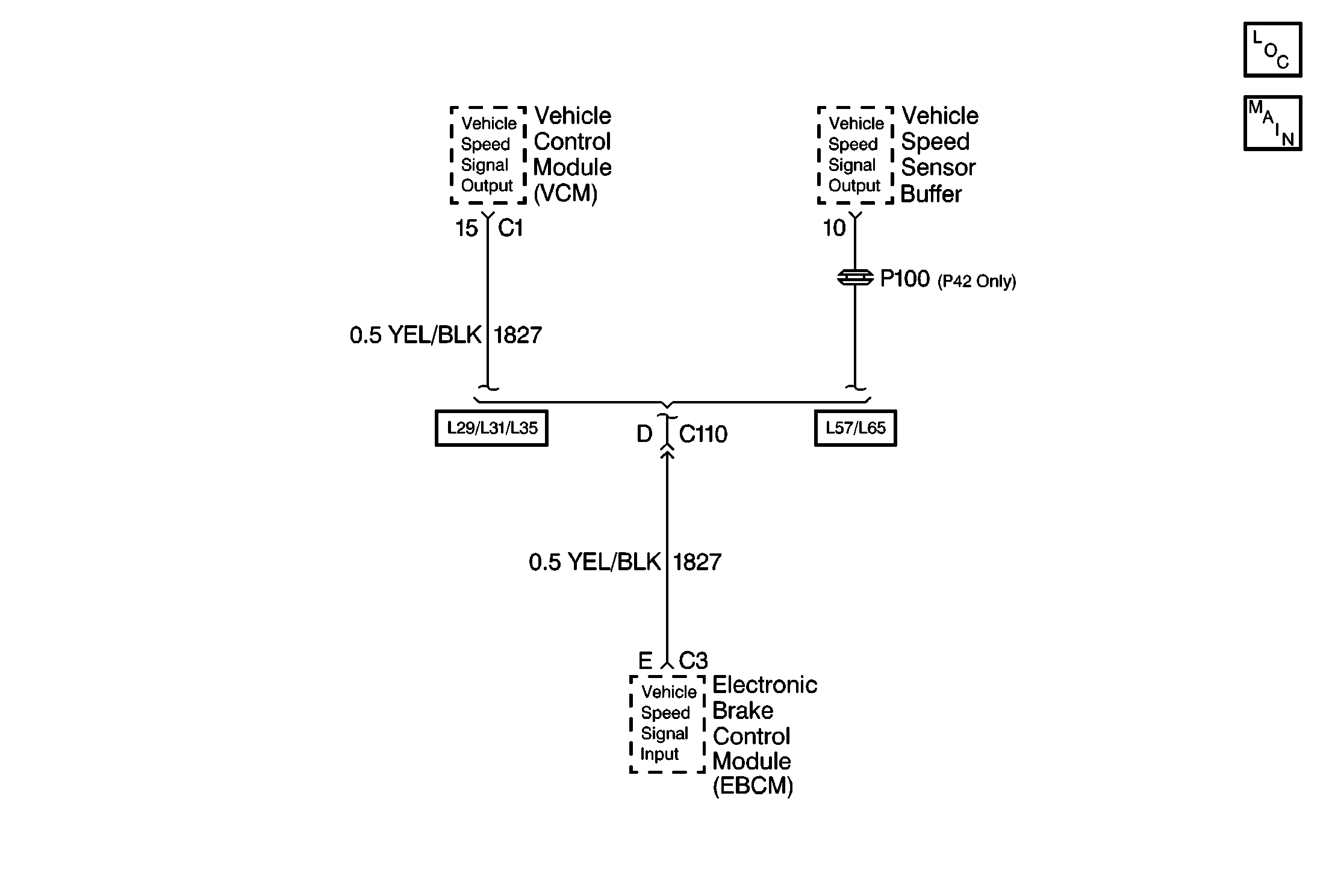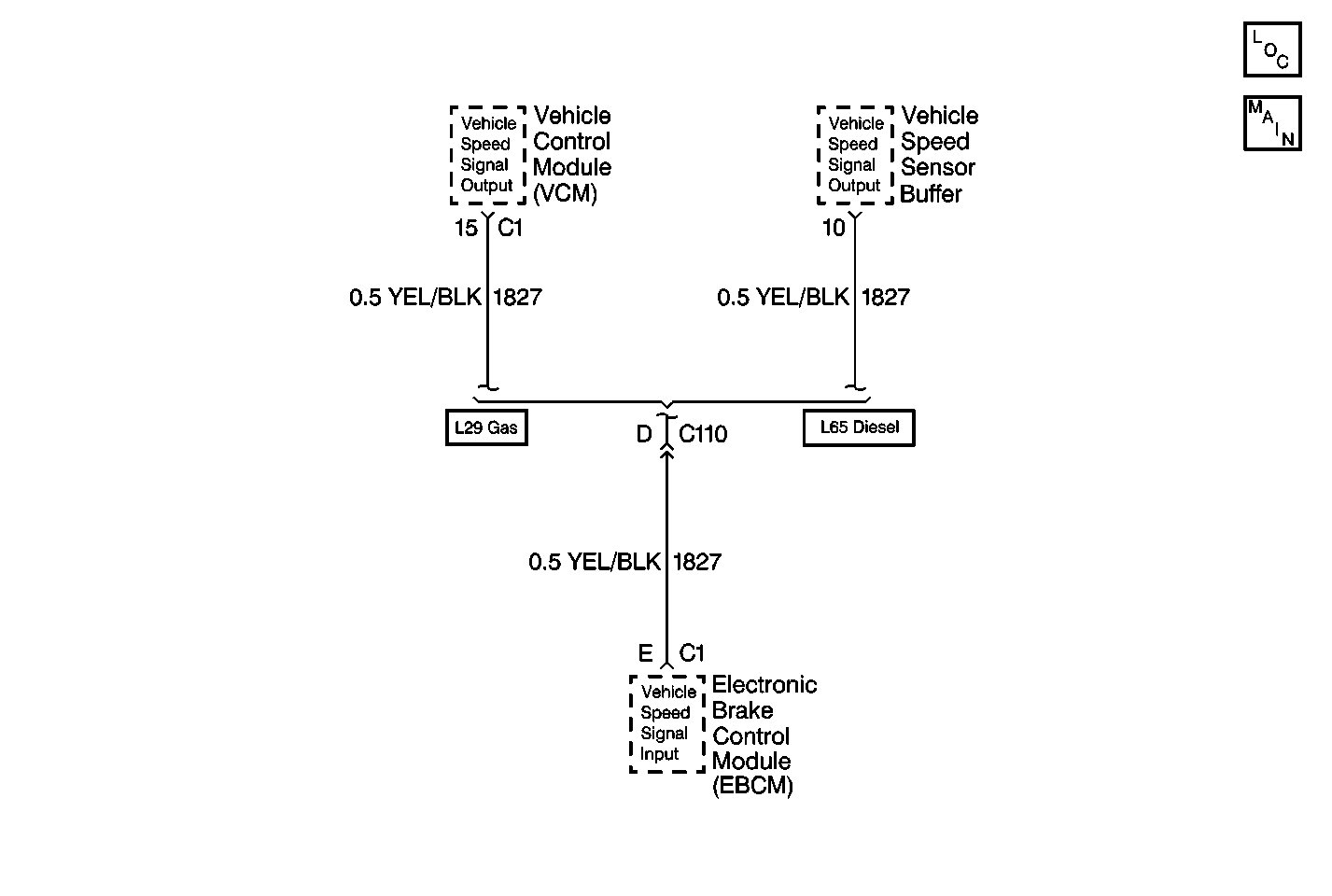DTC C0236 or C036 Rear Wheel Speed Signal Circuit Missing P32

Circuit Description
The EBCM receives the rear wheel speed signal from the Vehicle Control Module (VCM) for gas engine vehicles or the Vehicle Speed Sensor Buffer for diesel engine vehicles. The rear wheel speed signal originates from the Vehicle Speed Sensor (VSS) which is connected to the VCM (gas) or the Vehicle Speed Sensor Buffer (diesel) .
Conditions for Setting the DTC
EBCM losing the rear wheel speed signal for at least 5 seconds while the vehicle is moving above 13 km/h (8 mph) with the brake pedal released.
Action Taken When the DTC Sets
| • | The ABS indicator lamp turns on |
| • | The ABS disables |
DTC C0236 is an Ignition Latched DTC, which indicates that the above actions are true until the ignition is turned to OFF (even if the cause of the DTC is intermittent).
Conditions for Clearing the DTC
| • | Repair the conditions responsible for setting the DTC |
| • | Use the Scan Tool Clear DTCs function |
Diagnostic Aids
This malfunction can be caused by a malfunction in the EBCM, VCM (gas) Vehicle Speed Sensor Buffer (diesel), VSS or a fault in CKT 821, 822 or 1827.
In addition, any of the following conditions may cause an intermittent malfunction:
| • | A poor connection |
| • | Wire insulation that is rubbed through |
| • | A wire breaks inside the insulation |
Thoroughly check any circuitry that is suspected of causing the intermittent complaint for the following conditions:
| • | Backed out terminals |
| • | Improper mating |
| • | Broken locks |
| • | Improperly formed or damaged terminals |
| • | Poor terminal to wiring connections |
| • | Physical damage to the wiring harness |
If the customer says that the ABS indicator lamp is on only during humid conditions such as rain, snow, or vehicle wash, then thoroughly inspect the suspected circuits for signs of water intrusion. Use the following procedure:
- Spray the suspected area with a 5% salt water solution (two teaspoons of salt to 12 oz. of water)
- Drive the vehicle above 24 km/h (15 mph) for at least 30 seconds
If the DTC returns, replace the suspected harness.
Test Description
The numbers below refer to the steps in the diagnostic table:
-
This step uses the voltage output from the VCM (gas) or Vehicle Speed Sensor Buffer (diesel) to check the 1827 CKT.
-
This step checks the 1827 CKT for proper resistance.
-
This step checks for a short in the wiring between the ECBM and the VCM.
Step | Action | Value(s) | Yes | No |
|---|---|---|---|---|
1 | Was the Diagnostic System Check performed? | -- | Go to Step 2 | |
Is the voltage measurement equal to or greater than the specified range? | 10 V | Go to Step 4 | Go to Step 3 | |
Is the resistance measurement within the specified range? | 0-2 ohms | Go to Step 5 | Go to Step 8 | |
4 |
Did DTC C0236 set? | -- | Go to Step 6 | Go to Step 7 |
Using the J 39200 , measure the resistance from terminal E of the 10-way EBCM harness connector to ground. Is the resistance measurement within the specified range? | OL | Go to Engine Controls for Vehicle Speed Sensor Diagnosis | Go to Step 9 | |
6 | Replace the EBCM. Refer to Electronic Brake Control Module Replacement . Is the repair complete? | -- | -- | |
7 | Malfunction is intermittent, perform the following:
Is the repair complete? | -- | -- | |
8 | Repair the open in CKT 696. Refer to Wiring Repairs . Is the repair complete? | -- | -- | |
9 | Repair short to ground in CKT 696. Refer to Wiring Repairs . Is the repair complete? | -- | -- |
DTC C0236 or C036 Rear Wheel Speed Signal Circuit Missing P42

Circuit Description
The EBCM receives the rear wheel speed signal from the Vehicle Control Module (VCM) for gas engine vehicles or the Vehicle Speed Sensor Buffer for diesel engine vehicles. The rear wheel speed signal originates from the Vehicle Speed Sensor (VSS) which is connected to the VCM (gas) or the Vehicle Speed Sensor Buffer (diesel) .
Conditions for Setting the DTC
EBCM losing the rear wheel speed signal for at least 5 seconds while the vehicle is moving above 13 km/h (8 mph) with the brake pedal released.
Action Taken When the DTC Sets
| • | The ABS indicator lamp turns on |
| • | The ABS disables |
DTC C0236 is an Ignition Latched DTC, which indicates that the above actions are true until the ignition is turned to OFF (even if the cause of the DTC is intermittent).
Conditions for Clearing the DTC
| • | Repair the conditions responsible for setting the DTC |
| • | Use the Scan Tool Clear DTCs function |
Diagnostic Aids
This malfunction can be caused by a malfunction in the EBCM, VCM (gas) Vehicle Speed Sensor Buffer (diesel), VSS or a fault in CKTs 821, 822 or 1827.
In addition, any of the following conditions may cause an intermittent malfunction:
| • | A poor connection |
| • | Wire insulation that is rubbed through |
| • | A wire breaks inside the insulation |
Thoroughly check any circuitry that is suspected of causing the intermittent complaint for the following conditions:
| • | Backed out terminals |
| • | Improper mating |
| • | Broken locks |
| • | Improperly formed or damaged terminals |
| • | Poor terminal to wiring connections |
| • | Physical damage to the wiring harness |
If the customer says that the ABS indicator lamp is on only during humid conditions such as rain, snow, or vehicle wash, then thoroughly inspect the suspected circuits for signs of water intrusion. Use the following procedure:
- Spray the suspected area with a 5% salt water solution (two teaspoons of salt to 12 oz. of water)
- Drive the vehicle above 24 km/h (15 mph) for at least 30 seconds
If the DTC returns, replace the suspected harness.
Test Description
The numbers below refer to the steps in the diagnostic table:
-
This step uses the voltage output from the VCM (gas) or Vehicle Speed Sensor Buffer (diesel) to check the CKT 1827 .
-
This step checks the CKT 1827 for proper resistance.
-
This step checks for a short in the wiring between the ECBM and the VCM.
Step | Action | Value(s) | Yes | No |
|---|---|---|---|---|
1 | Was the Diagnostic System Check performed? | -- | Go to Step 2 | |
Is the voltage measurement equal to or greater than the specified range? | 10 V | Go to Step 4 | Go to Step 3 | |
Is the resistance measurement within the specified range? | 0-2 ohms | Go to Step 5 | Go to Step 8 | |
4 |
Did DTC C0236 set? | -- | Go to Step 6 | Go to Step 7 |
Using the J 39200 , measure the resistance from terminal E of the 10-way EBCM harness connector to ground. Is the resistance measurement within the specified range? | OL | Go to Engine Controls. | Go to Step 9 | |
6 | Replace the EBCM. Refer to Electronic Brake Control Module Replacement . Is the repair complete? | -- | -- | |
7 | Malfunction is intermittent, perform the following:
Is the repair complete? | -- | -- | |
8 | Repair the open in CKT 696. Refer to Wiring Repairs . Is the repair complete? | -- | -- | |
9 | Repair short to ground in CKT 696. Refer to Wiring Repairs . Is the repair complete? | -- | -- |
